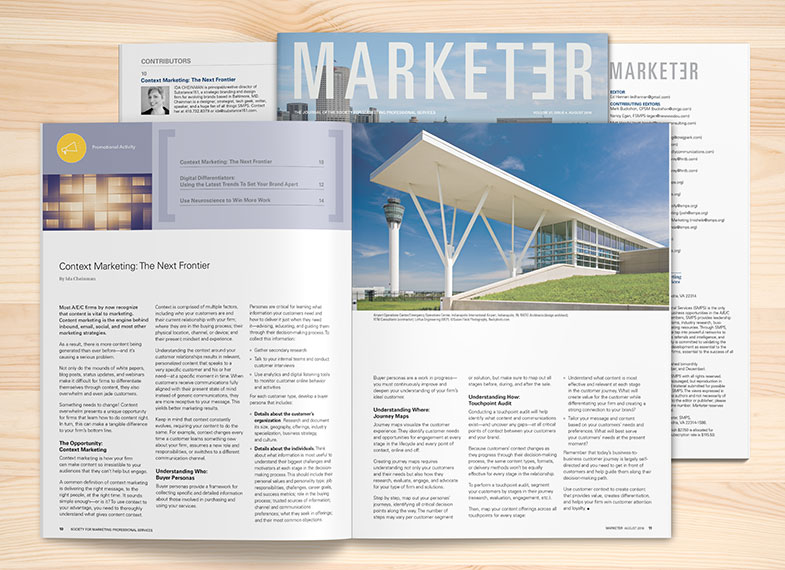
This article was first published in the Marketer – Journal of the Society for Marketing Professional Services (SMPS).
As a result, there is more content being generated than ever before – and it’s causing a serious problem.
Not only do the mounds of white papers, blog posts, status updates, and webinars (the list goes on) make it more difficult for firms to differentiate through content, but also they make customers overwhelmed and even jaded.
Something needs to change! Content overwhelm presents a unique opportunity for firms that learn how to do content right – in a way that realizes its full potential and results in a tangible difference to the firm’s bottom line.
Context marketing is how your firm can make content so irresistible to your audiences that they can’t help but engage.
A common definition of context marketing is delivering the right message, to the right people, at the right time. Simple enough – or is it? To use context to your advantage, you need to thoroughly understand what gives content context.
Context is comprised of multiple factors, including who your customers are and their current relationship with your firm; where they are in the buying process; their physical location, channel, or device; and their present mindset and experience.
Understanding the context around your customer relationships results in relevant, personalized content that speaks to a very specific customer and his or her need – at a specific moment in time. When customers receive communications fully aligned with their present state of mind – instead of generic communications – it yields better marketing results.
Keep in mind that context constantly evolves, requiring your content to do the same. For example, context changes every time a customer learns something new about your firm, assumes a new role and responsibilities, or switches to a different communication channel.
Buyer personas provide a framework for collecting specific and detailed information about those involved in purchasing and using your services.
Personas are critical for learning what information your customers need and how to deliver it just when they need it – advising, educating, and guiding them through their decision-making process.
To collect this information:
For each customer type, develop a buyer persona that includes:
Buyer personas are a work in progress – you must continuously improve and deepen your understanding of your firm’s ideal customer.
Also read: What You Don’t Know Can Kill Your Brand: Deep Dive into Customer Research
Journey maps are used to visualize the customer experience. They help identify customer needs and opportunities for engagement at every stage in the lifecycle and every point of contact – online and off.
Creating journey maps requires understanding not only your customers and their needs but also their process of researching, evaluating, engaging, and advocating for your type of firm and solutions.
Step by step, map out your personas’ journeys, identifying all critical decision points along the way. The number of steps may vary per customer segment or solution, but make sure to map out all stages – before, during, and after the sale.
Conducting a touchpoint audit will help identify what content and communications exist – and uncover any gaps – at all critical points of contact between your customers and your brand.
Because customers’ context changes as they progress through their decision-making process, the same content types, formats, or delivery methods won’t be equally effective for every stage in the relationship.
To perform a touchpoint audit, first segment your customers by stages in their journey (research, consideration, engagement, etc.).
Then, map your content offerings across all touchpoints for every stage.
1. Understand what content is most effective and relevant at each stage in the customer journey. Ask: What will create value for the customer while differentiating our firm and creating a strong connection to our brand?
2. Tailor message and content based on your customers’ needs and preferences. Ask: How can we best engage each customer persona at all critical moments in their decision making process? What will best serve our customers’ needs at the present moment?
Remember that today’s B2B customer journey is largely self-directed and you need to get in front of customers and help guide them along their decision-making path.
Use customer context to create content that provides value, creates differentiation, and helps your firm win customer attention and loyalty.